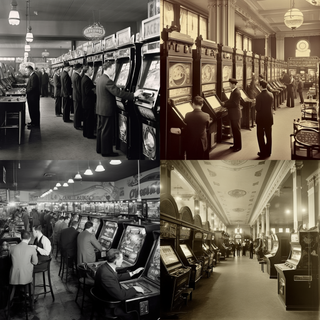Arcade Revolution: The Decline of Billiards in America and the Rise of Slot Machines and Pinball (1900-1950)
In the early decades of the twentieth century, billiards was the dominant social pastime in America, with billiard halls scattered across towns and cities as a central hub of recreational and social life. However, by the mid-20th century, the once-thriving game found itself gradually supplanted by emergent arcade amusements, specifically slot machines and pinball. The transition from billiards to these arcade attractions did not happen overnight but was a product of a series of economic, social, and technological factors that played out over the first half of the century.
At the turn of the 20th century, billiards was well-established in the American social landscape. Billiard tables were common fixtures in saloons and clubs, places where men gathered to drink, socialize, and gamble. The game was a symbol of sophistication and masculine leisure, with its intricate rules and strategies.
However, the early 1900s saw the introduction of slot machines, and later, pinball machines. Initially, these games were not considered serious competitors to billiards as they were more associated with women and children, thus less threatening to the masculine image of the billiard halls. However, they steadily gained popularity due to their ease of play, low cost, and the possibility of monetary rewards.
The First World War marked a turning point. As a vast number of men left their local communities for military service, billiard halls suffered a loss in patronage. In contrast, slot machines and pinball games, with their broad appeal and accessibility, began to fill the void. The economic hardship brought about by the war also made the low-cost, high-reward nature of these arcade games more attractive.
In the 1920s and 1930s, as the nation grappled with Prohibition and then the Great Depression, billiards faced additional challenges. Prohibition led to the closure of many saloons where billiard tables were common fixtures. The Great Depression further exacerbated the situation, making the relatively expensive game of billiards an unaffordable luxury for many. In contrast, slot machines and pinball, inexpensive and potentially lucrative, thrived.
The final blow to billiards came with the advent of World War II. As the United States entered the war, the manufacturing of billiard tables, a non-essential item, was restricted due to resource constraints. On the other hand, the production of pinball machines, often seen as a morale booster, continued. Furthermore, the post-war economic boom led to an increase in disposable income, much of which was spent on leisure activities like pinball and slot machines.
By 1950, the landscape of American recreation had transformed. The once-dominant billiards had been sidelined, while slot machines and pinball had become the leading forms of amusement. Billiard halls, once the nexus of social life in many communities, had been replaced by arcades filled with blinking lights and ringing bells.
This narrative serves as a reminder of how societal, economic, and technological shifts can dramatically alter the course of recreational practices. While the decline of billiards and the rise of slot machines and pinball were facilitated by multiple factors, at their core, they reflected the changing dynamics of American society in the first half of the 20th century.

